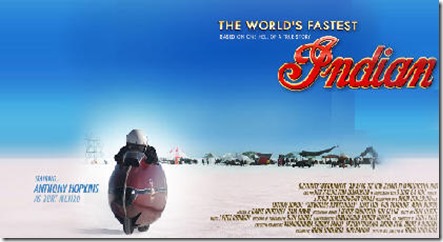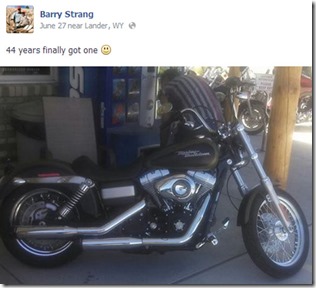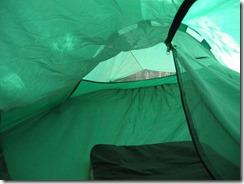 [Originally published as "Trials Action" in Minnesota Motorcycle Monthly, October/November 2000 about the AMA/NATC Observed Trials Championship rounds (9 & #10) held in Duluth, MN.]
[Originally published as "Trials Action" in Minnesota Motorcycle Monthly, October/November 2000 about the AMA/NATC Observed Trials Championship rounds (9 & #10) held in Duluth, MN.]
Once again, Minnesota hosted two rounds of the AMA/NATC National Observed Trials Series at the Spirit Mountain Ski Area. This year, the Duluth event turned out to be the climatic moment in the championship. The Duluth organization managed to snag the last two rounds of the 2000 national series and the title was down to the wire. Geoff Aaron, on a Gas Gas this year and attempting to win a sixth US National Championship, needed one third place or better finish in this event to hold off Ryon Bell (Montesa).
Aaron had won both rounds (7 & 8) in Sequatchie, Tennessee and seemed to have it wrapped up. However, in the kind of move that makes spectators love watching Aaron and must drive the factory guys crazy, Aaron was not riding his factory bike for the Minnesota event. He was riding a new, bone-stock Gas Gas that was probably no better prepared than the bikes ridden 90% in the Support classes. On Saturday morning, one of the factory reps just shook his head as he told me, "He didn't even move his shock or his motor over to the new bike. It takes at least two months to break in a shock and he's only had the bike a couple of days." Obviously, some folks thought Aaron was tossing his 6th championship into the wind.
Add to all this motorcycle stuff, we have Duluth in the summer.
I get the feeling that Twin City'ers think of Duluth as a "little sister city." Sort of the attitude that LA has toward San Francisco. That's, actually, a fair comparison. Without knocking the Cities, because I love this place, Duluth has The Lake and The Hills and all the incredible vistas that come with those two assets. The same weekend as the trials, Duluth had the Bay Front Blues Festival going. What to do and where to go? So many choices and so little time. On August 12, 2000, there was no place on earth I'd have rather been than Duluth, Minnesota.
"The Incredible Invisible Sport," that's what they ought to call it. Observed Trials (OT) is just not descriptive enough. Maybe paying slight attention to my griping about the lack of visibility from the 1998 Duluth event, this year, the Duluth event's promoters advertised in MMM. I saw at least one event poster at a Twin Cities motorcycle shop. Still, when I rode into the Spirit Mountain Ski Area, it was impossible to tell something significant was going on. I rode well into the park before I spotted a single sign. Since I was operating on my usual level of preparation and forethought, I had almost made the assumption that I was here on the wrong weekend or that the event was happening somewhere else. For some odd reason, I hadn't seen a single trailered trials bike in a motel parking lot, so it looked like I was in the wrong place at the wrong time.
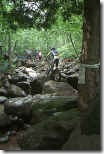 That's incredible for a whole collection of reasons. First, in a state where there appear to be as many motorcycles as snowmobiles and jet skis, you'd think anyone who loves motorcycling would be in Duluth for the final rounds of the National Observed Trials Championship. Second, lots of us can argue that trials is the best motorcycling spectator sport. Third, you can't believe what these guys do on motorcycles until you've seen it in person. Fourth, where else will you see huge numbers of $6,000, 150 lb., 250cc motorcycles?
That's incredible for a whole collection of reasons. First, in a state where there appear to be as many motorcycles as snowmobiles and jet skis, you'd think anyone who loves motorcycling would be in Duluth for the final rounds of the National Observed Trials Championship. Second, lots of us can argue that trials is the best motorcycling spectator sport. Third, you can't believe what these guys do on motorcycles until you've seen it in person. Fourth, where else will you see huge numbers of $6,000, 150 lb., 250cc motorcycles?
Somewhere I read that Minnesota motorcyclists put on more miles per capita per year than any other state's riders. If you look at the warm weather event schedule, there's something on two wheels going on all the time here. If you take a Saturday afternoon cruise into Minnesota or Wisconsin's back roads, it's a two-wheeled world out there. In March, we fill the Convention Center to look at any damn two-wheeled-associated thing the manufacturers want to sell us. A week later, we packed the Dome to go deaf watching Supercrossers. We're a biking kind of place.
OT is made for spectating. Look at the pictures and notice where the spectators are, relative to the riders. We're practically part of the sections. You can line up, inches from where a world class rider will pass or fail. You can even make smartass comments about how they cheated on a section and get a reaction. How can you beat that?
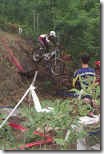 We all know that Tom Cruise can't do a stoppie or spin a bike on its front wheel or launch himself into a fight from a moving crotch rocket, but we all saw it a zillion times when MI2 was being previewed on the tube. Some of us don't believe that Cruise can ride a Harley through an empty parking lot, let alone do stunts on a Triumph. With that cynical background, you won't believe what Geoff Aaron or Ryon Bell or any of these top riders can do on a motorcycle, even after you've seen it with your own eyes. If Aaron was taking bets on his being able to leap a tall building with a couple of suspension bounces and a brick for a launch pad, I'd put my money on him.
We all know that Tom Cruise can't do a stoppie or spin a bike on its front wheel or launch himself into a fight from a moving crotch rocket, but we all saw it a zillion times when MI2 was being previewed on the tube. Some of us don't believe that Cruise can ride a Harley through an empty parking lot, let alone do stunts on a Triumph. With that cynical background, you won't believe what Geoff Aaron or Ryon Bell or any of these top riders can do on a motorcycle, even after you've seen it with your own eyes. If Aaron was taking bets on his being able to leap a tall building with a couple of suspension bounces and a brick for a launch pad, I'd put my money on him.
OT is not only a well kept secret, but also the bikes appear to be vanishing. My old 1974 RL250cc Suzuki weighed about 300 lbs. My 1986 TY350 sports about 225 lbs of pork. A 2000 Bultaco weighs 154 lbs! At this rate, in another decade riders will be strapping trials "bikes" to their feet, like rollerblades.
Ah, the motorcycles. My how much difference two years makes. Last time I was here, I spotted one proto-Montesa-Honda (labeled Montesa everywhere but in Honda's homeland, where Honda calls a Honda "a Honda") in the crowd of Gas Gas, Beta, Fantic, and ancient Yamaha's. This year, they're back! Practically everyone is back.
Montesa, a Spanish motorcycle company that died in 1978, has "partnered" with Honda (Honda bought Montesa's body and casket in the 1980's) to produce frames and motors. Since motorcycle frames and motors are pretty much the heart and guts of a motorcycle, I think it's pretty safe to assume Honda designed the bike. The Montesa Cota 315R is assembled and boxed for shipment in Spain. Whoever made the bikes, there were Cota 315R's everywhere. Some of the 1998 bikes even looked old. If this event was any kind of indication of their success, Honda must be pretty satisfied with its backdoor adventure into OT. Especially after the financial mess that trials turned out to be for Japan in the 1970's.
Two years ago, the Montesa-Honda was barely out of prototyping. This year, Dougie Lampkin won his 4th World Championship in a row on a Montesa-Honda and everybody seems to have jumped on that bandwagon. Next year, Montesa will field a Dougie Lampkin Signature Model. Buy one and I will guarantee that you'll have the coolest, weirdest bike in your block. It will be a $6,000, 150 lb. 250cc motorcycle with a 45mph top speed and more first gears than you can handle (at least 4 of 'em). The Montesa 315R is a 249cc bike. Go figure.
Bultaco, has become yet another reincarnated Spanish motorcycle logo that died near the end of 1979. The dead shell of the company was propped up by the Spanish government until the mid-80's, when the logo was about all that was left of that great company. The thumb's up (Bultaco logo) appears to be live and well in Y2K.
This time, two years ago, the Bultaco Sherco looked like fantastic vaporware. If you were a diligent Yahoo hacker, you could find pictures of the proposed bike on the web. The manufacturer's story seemed so vague that only a true believer would have expected a real motorcycle to come out of that fantasy. This year, if the bike that just dusted you along the spectator trail wasn't a Montesa it was a Bultaco. While the first year bike was a success and a decent bike, the 2000 model is the lightest trialer on the market and the importer is making a serious dent in the established trials manufacturer's sales. Ryan Young, the pre-Aaron five-times National Champion, is behind Bultaco's PR and marketing success and the company has serious financial backing. A couple of manufacturer's reps complained that Bultaco had absorbed almost all of the available advertisement space in the trials press.
This year, Scorpa-Yamaha had a new trialer at Duluth, but no Champ rider. Yamaha appears to be replicating the act that Honda has staked out. That tactic seems to be to do the engineering and let someone else deal with the distribution. Honda, for example, did all of the engineering for the Montesa, but is letting the Montesa brand name take the risk and the credit for the bike. Yamaha is doing the same thing with the French "assembled" Y2K Scorpa. The Scorpa has a Yamaha motor and frame. The price is $5780. The bike has an actual tank, which is properly artistically sculpted. Since the Big Four grossly overestimated the trials market, back in the 1970's, this may be how they are protecting their faces from another of OT's vanishing acts. At any rate, I saw a couple of the Yamaha-Scorpa Y2K's and it's a very flashy looking bike.
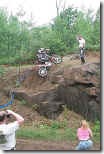 Two years ago, when it seemed that everyone was riding for Gas Gas, the National Champion, Geoff Aaron, was on a Beta. In Y2K, the majority of pros and experts are on Montesas and Bultacos and Aaron has moved over to a Gas Gas. (The Beta booth was still showing Aaron posters and the reps looked pretty lonely and dejected. In a "leading user" sport like OT, when you're out, you're out.)
Two years ago, when it seemed that everyone was riding for Gas Gas, the National Champion, Geoff Aaron, was on a Beta. In Y2K, the majority of pros and experts are on Montesas and Bultacos and Aaron has moved over to a Gas Gas. (The Beta booth was still showing Aaron posters and the reps looked pretty lonely and dejected. In a "leading user" sport like OT, when you're out, you're out.)
In a number of ways, Geoff Aaron is smoothly contrary. He don't find him riding the "bike of the year" and he's known for taking hard lines through sections, just to show that he doesn’t have to follow the pack. Or because he is seeing something nobody else can see. Knowledgeable spectators keep an eye out for when Aaron is going to be at a section because you can always count on something specially cool happening when he rides.
While trudging around the 15-mile course, I heard a half-dozen mildly masked criticisms about Aaron's ability to "market himself." He's also reputed to be the only guy on the circuit who's actually making a "good living" riding trials. Could some of the sour grapes be jealousy? Somebody has to break that ground for everyone else to follow. I suppose that guy always has to live with the nitpicking from his contemporaries, though.
I'm not going to argue that I might have a bias, though. I do. My favorite sort of athlete has always been the guys who make really hard stuff seem simple and impossible stuff look just a bit harder. After watching a gaggle of Champs struggle with a section, Aaron can sometimes make it look like someone applied an invisible layer of pavement over the section. Sometimes, he can glide through a pile of rubble so effortlessly that you'd think anyone could do it. Then, someone follows his route through the same section and goes wheels up for his trouble. I love to watch Geoff Aaron ride a motorcycle.
Two years ago, spectators were treated with a world class riding performance from Tommi Ahvala, in exhibition (not in competition) with the US National tour. This year, Ahvala is touring with the "Team Extreme Trials Showcase" and his overpowering presence probably wasn't missed by the American competitors. (Aaron, Kempkes, and Bell also ride the Showcase circuit, when it doesn't compete with the National series.) Two years ago at this same event, he put on a world class show of riding that had to have been humbling to the rest of that year's American riders. I expect jumping Volkswagens and climbing over-sized stairs pays a lot better than getting dirty with the peasants. It looks like the closest Ahvala's going to get to Minnesota is at the Septemberfest in Omaha this . . . September.
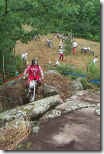 Saturday morning started off with a short burst of rain that cut the dust, disturbed the bugs, and made walking the loop so muggy that I had to stop and defog my glasses every 100 yards. But, until about 2:00PM, the rain and cloud cover kept the hiking tolerable and the intermittent showers provided a bit of entertainment and air conditioning. The down side was that walking to the sections was the hardest, slickest hiking I've done in years. By the time I finished my 1st loop, I'd fallen a half dozen times, lost two very nice pens, and protected my camera with my head, twice.
Saturday morning started off with a short burst of rain that cut the dust, disturbed the bugs, and made walking the loop so muggy that I had to stop and defog my glasses every 100 yards. But, until about 2:00PM, the rain and cloud cover kept the hiking tolerable and the intermittent showers provided a bit of entertainment and air conditioning. The down side was that walking to the sections was the hardest, slickest hiking I've done in years. By the time I finished my 1st loop, I'd fallen a half dozen times, lost two very nice pens, and protected my camera with my head, twice.


Checker joke: "How do you tell a Champ from an Expert from a Support rider? The Champs' number plate has a 'champ' decal and the Champs have a real serious look on their faces." There were nine Champs at the Duluth rounds. Most of them looked like they were having a lot of fun, since the championship series was going to be determined more by a complete Geoff Aaron breakdown, rather than a magical great ride from Ryon Bell.
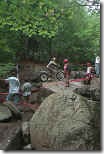 But at least one of the Champs had something different on his face. Native Midwesterner (Nebraska), Jess Kempkes, often looked pained and disappointed. It might be that he was wincing from all the earrings. He's probably working on his Trials des Nations look for Spain, later this year. Jess is one of the most adventurous and entertaining riders on the trials circuit and his look is probably just part of the persona he's building. Whatever, Kempkes rode for a 3rd and a 4th this weekend and picked some spectacular routes through the rocks.
But at least one of the Champs had something different on his face. Native Midwesterner (Nebraska), Jess Kempkes, often looked pained and disappointed. It might be that he was wincing from all the earrings. He's probably working on his Trials des Nations look for Spain, later this year. Jess is one of the most adventurous and entertaining riders on the trials circuit and his look is probably just part of the persona he's building. Whatever, Kempkes rode for a 3rd and a 4th this weekend and picked some spectacular routes through the rocks.
On Saturday, I was despairing for the sport. At 9:30AM, there were only a couple bikes in the parking lot and just a few more at the end of the day. Saturday, the parking lot wasn't even close to full and it wasn't hard to find a spot, on most of the sections, to spectate alone. Sunday, however, was a different deal. There were, easily, as many bikes as cars in the lot and every section had a good turnout of spectators. I guess "On Any Sunday" applies to spectators, too. Some of the Champs-only sections were impossible to get near, if you didn't stake out a spot before the riders got to the section.
Maybe the crowd was a perception thing. The organizers, Upper Midwest Trials Association (UMTA), said they had about 300 paid spectators, both days. They suspected at least 100 more snuck in each day. I must have been following the crowd on Sunday. UMTA was satisfied with the turnout and they may try to turn the Duluth round into an annual event. They're petitioning for a World Round in 2003. If those of you who didn't go to the Nationals miss out on the World competition, I think you should be condemned to a life on four wheels.
Like racing everywhere, the pits were swarming with little rich kids on expensive bikes. I mean "little" kids, like 6-8 year olds. If that doesn't chap your shorts in jealousy, you're a better man than me. At the previous event, in Kentucky, a 6-year old boy was killed, when he collided head-on with another rider. I saw a good number of kids pressing their luck on the practice grounds and in the pits, during this event. Trials isn't any worse at managing marginal parents and their kids than any other sport, but I sure wish it was.
If you still think that OT just isn't a Minnesota sort of motorcycling thing, US Montesa is the national distributor and they're located right here in Glen Prairie. Write 'em at usmontesa@cs.com or call 612-937-8720. Don't forget to tell them that I sent you and they should drop off my 315R Cota sample/payola in Little Canada.
Minnesota Results
Round 9, Aug. 12th Champ class.
Round 10, Aug. 13th Champ class.
1. Raymond Peters (Bultaco)
2. Ryon Bell (Montesa)
3. Jess Kempkes (Gas Gas)
4. Geoff Aaron (Gas Gas)
5. Travis J.Fox (Bultaco)
6. Wilson Craig (Montesa)
7. Dan Johnson (Bultaco)
8. Andy Johnson (Montesa)
1. Ryon Bell (Montesa)
2. Geoff Aaron (Gas Gas)
3. Ray Peters (Bultaco)
4. Jess Kempkes (Gas Gas)
5. Travis J. Fox (Bultaco)
6. Wilson Craig (Montesa)
7. Dan Johnson (Bultaco)
8. Andy Johnson (Montesa)
Along with the Champ class, there were 11 other classes for trialers from Expert to kids to over-60 riders. I heard the oldest rider was around 70 and the youngest was 8.
So, Geoff Aaron finished 4th on Saturday and 2nd on Sunday and he's is the 2000 US National Champion, for the 6th time in that many years. The Trials des Nations competition in Spain is his next big event. I hope he and the other US riders (Kempkes, Raymond Peters, and Cory Pincock are also on the team) kick some butt this year. Don't count on it, though. It's a big time sport in the rest of the world, especially Europe, and their guys have been doing this at a world-class level for a long, long time.




